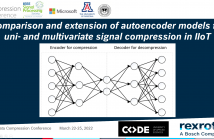- Bayesian learning; Bayesian signal processing (MLR-BAYL)
- Bounds on performance (MLR-PERF)
- Applications in Systems Biology (MLR-SYSB)
- Applications in Music and Audio Processing (MLR-MUSI)
- Applications in Data Fusion (MLR-FUSI)
- Cognitive information processing (MLR-COGP)
- Distributed and Cooperative Learning (MLR-DIST)
- Learning theory and algorithms (MLR-LEAR)
- Neural network learning (MLR-NNLR)
- Information-theoretic learning (MLR-INFO)
- Independent component analysis (MLR-ICAN)
- Graphical and kernel methods (MLR-GRKN)
- Other applications of machine learning (MLR-APPL)
- Pattern recognition and classification (MLR-PATT)
- Source separation (MLR-SSEP)
- Sequential learning; sequential decision methods (MLR-SLER)

- Read more about DynSNN: A Dynamic Approach to Reduce Redundancy in Spiking Neural Networks
- Log in to post comments
Current Internet of Things (IoT) embedded applications use machine learning algorithms to process the collected data. However, the computational complexity and storage requirements of existing deep learning methods hinder the wide availability of embedded applications.
Spiking Neural Networks~(SNN) is a brain-inspired learning methodology that emerged from theoretical neuroscience, as an alternative computing paradigm for enabling low-power computation.
- Categories:
 34 Views
34 Views
- Read more about Comparison and extension of autoencoder models for uni- and multivariate signal compression in IIoT
- Log in to post comments
In the production plants in the era of industry 4.0, every unit in the production process will generate and transmit data. Transmitting this data in real-time is not unrestrictedly feasible due to the limited bandwidth of the Internet, and processing on the edge device of the unit is also not conceivable due to the limited computing capacity of the device.
- Categories:
 31 Views
31 Views
- Read more about Efficient decoder for learned image compression via structured pruning
- Log in to post comments
We propose a structured pruning method to achieve a light-weighted decoder of learned image compression to accommodate various terminals. The structured pruning method identifies the effectiveness of each channel of decoder via gradient ascent and gradient descent while maintaining the encoder and entropy model. To our best knowledge, this paper is the first attempt to design a structured pruning method for universal pretrained learned image compression.
- Categories:
 41 Views
41 Views
- Read more about Towards explainable semantic segmentation for autonomous driving systems by multi-scale variational attention
- Log in to post comments
- Categories:
 53 Views
53 Views
- Read more about A Joint Convolutional and Spatial Quad-Directional LSTM Network for Phase Unwrapping
- Log in to post comments
Phase unwrapping is a classical ill-posed problem which aims to recover the true phase from wrapped phase. In this paper, we introduce a novel Convolutional Neural Network (CNN) that incorporates a Spatial Quad-Directional Long Short Term Memory (SQD-LSTM) for phase unwrapping, by formulating it as a regression problem. Incorporating SQD-LSTM can circumvent the typical CNNs' inherent difficulty of learning global spatial dependencies which are vital when recovering the true phase. Furthermore, we employ a problem specific composite loss function to train this network.
- Categories:
 18 Views
18 Views
- Read more about A Quaternion-Valued Variational Autoencoder
- Log in to post comments
Deep probabilistic generative models have achieved incredible success in many fields of application. Among such models, variational autoencoders (VAEs) have proved their ability in modeling a generative process by learning a latent representation of the input. In this paper, we propose a novel VAE defined in the quaternion domain, which exploits the properties of quaternion algebra to improve performance while significantly reducing the number of parameters required by the network.
- Categories:
 11 Views
11 Views
- Read more about SALIENCY-DRIVEN VERSATILE VIDEO CODING FOR NEURAL OBJECT DETECTION
- Log in to post comments
Saliency-driven image and video coding for humans has gained importance in the recent past. In this paper, we propose such a saliency-driven coding framework for the video coding for machines task using the latest video coding standard Versatile Video Coding (VVC). To determine the salient regions before encoding, we employ the real-time-capable object detection network You Only Look Once (YOLO) in combination with a novel decision criterion. To measure the coding quality for a machine, the state-of-the-art object segmentation network Mask R-CNN was applied to the decoded frame.
- Categories:
 44 Views
44 Views
- Read more about DEMYSTIFYING MODEL AVERAGING FOR COMMUNICATION-EFFICIENT FEDERATED MATRIX FACTORIZATION
- Log in to post comments
- Categories:
 35 Views
35 Views
In this paper, we consider the problem of Federated Learning (FL) under non-i.i.d data setting. We provide an improved estimate of the empirical loss at each node by using a weighted average of losses across nodes with a penalty term. These uneven weights to different nodes are assigned by taking a novel Bayesian approach to the problem where the problem of learning for each device/node is cast as maximizing the likelihood of a joint distribution. This joint distribution is for losses of nodes obtained by using data across devices for a given neural network of a node.
- Categories:
 12 Views
12 Views